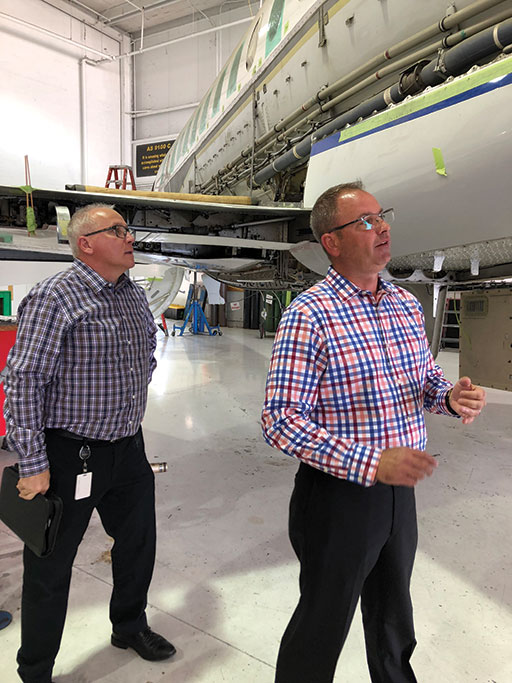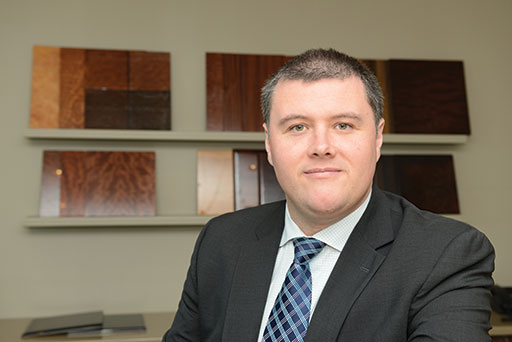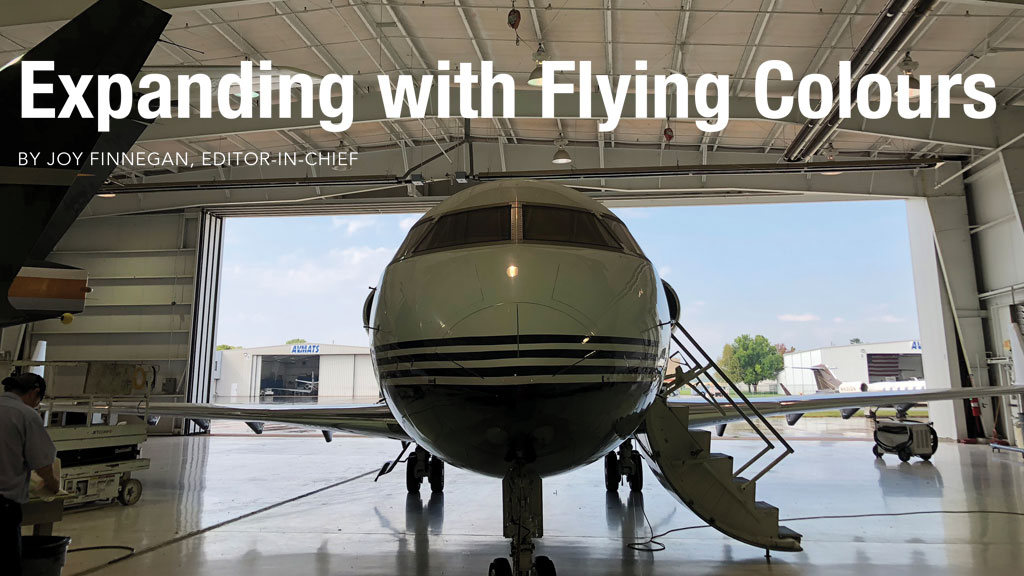Flying Colours will be adding more than 140,000 square feet to its North American footprint as it continues an ambitious expansion and embarks on its largest infrastructure growth to date.
Plans are currently being finalized for the groundbreaking of a brand-new hangar by the end of fall 2018 at the Peterborough, Ontario, Canada facility. The company says the additional hangar, the fourth at Flying Colours Peterborough headquarters, is needed to provide additional capacity for completions, refurb and heavy maintenance work on large jet airframes.
The purpose-built hangar will be divided into three distinct zones. A new 40,000-square-feet, climate controlled, state-of-the-art paint shop will be added, supplementing the two existing dedicated paint shops. Large enough to accommodate business jets up to Global 7500, Boeing Business Jet or Airbus A220 (formerly known as the Bombardier C-Series) size airframes it will fulfill the higher volume of paint jobs passing through the facility. A second area of 40,000 square feet has been designed to enable heavy maintenance and/or interior work on up to four Global 6000-size aircraft to take place simultaneously. Two higher levels will be used for new customer offices, a second dedicated design-center at the facility, storage and general office space. The total office space will cover more than 20,000 square feet bringing the hangar footprint to more than 100,000 square feet in total when it opens in mid-2019.
At the company’s Chesterfield, St. Louis, Mo. Facility, a fifth hangar will be inaugurated on December 1st. The 30,000-square-feet area will be large enough to handle up to three large-jet maintenance, avionics upgrades and interior projects at once, including Bombardier Global and larger Gulfstream models. The additional capacity dove tails with the expanded interiors and cabinetry workshop that opened in January of this year. Together the shops will support the multiple aircraft projects being undertaken at the facility. A further 18,000 square feet of customer lounges, office space, and storage area will form the second floor.

On a recent visit to that Chesterfield, Mo. site, Aviation Maintenance had the chance to meet with Dave Stewart, VP operations and general manager and Kevin Kliethermes, director of sales, to learn how the company is handling their growth. Stewart, formerly with Toyota Motors, brings a fervent love of lean and a deep understanding of the Toyota management philosophy. He had never been in aviation in any capacity before coming on board with Flying Colours.
“Was I brought here to bring lean to the company? Probably. We’ve come a long way. We have a long way to go.” Part of the philosophy, Stewart says, is that even though Toyota has been embracing lean culture for decades, they are still working towards improvement.

Some of the ideas Stewart has been touting since coming on board are direct from the Toyota playbook such as individual responsibility for roles, continuous improvement, eliminating waste, stopping to fix problems, getting it right the first time and using visual cues so no problems are hidden. When he first came on board, Stewart says there weren’t clear goals as far as meeting schedules was concerned. “We now have a scheduling and planning department that is tied into our material planning so we get our kits out to production when we need them. It is a very linked-together process from the day we find out about a project until the day it delivers. Now we put a lot of emphasis into our scheduling to be able to handle it,” Stewart says.
Flying Colours says this expansion, their largest investment to date, has been driven by the need for increased capacity due to growth in the business aviation sector. The company sees an active pre-owned market driving a rise in refurbishment demand, and heavy maintenance checks for more models coming due. Connectivity is also stimulating more avionics upgrades across numerous platforms, as well as the upcoming ADS-B Out mandate. More than 100 employees will be hired across the two sites.
“We were literally running out of space to deliver all the services that our clients were requesting, so took the decision to increase our footprint significantly at both of our North American sites,” says Sean Gillespie, EVP, Flying Colours. “The business aviation sector is more buoyant than it has been for some time and with our Bombardier ASF status, our breadth of experience working on numerous different aircraft types, and the fact that we can offer a multitude of skills under one roof, so reducing aircraft downtime, is making us very attractive to a wider range of customers.”
The Peterborough facility recently re-delivered its one hundredth major retrofit of a Bombardier Challenger model. The Bombardier Challenger 604, delivered in the first week of October 2018, underwent a major overhaul of the cabin, avionics, connectivity and fuselage.
The private owner also took the opportunity to update cabin-connectivity with the Gogo AVANCE L3 air-to-ground connectivity system installed to provide WiFi access for voice, email, web browsing, moving maps, and a selection of movies and TV programs across the North American region. Passengers will also enjoy inflight entertainment courtesy of the Rockwell Collins Venue system with new monitors installed at the front and aft of the cabin.
The flight deck was also treated to a major overhaul with Rockwell Collins’ Future Airspace Navigation System (FANS) 1/A installed combined with installation of ADS-B Out tracking equipment, for which Flying Colours holds the STC on Challenger 604 types.
As we tour the facility, Stewart peppers everything he says about the work flow at the company with Toyota process improvement phrases: just-in-time sourcing, kaizen circles, gemba walks, plan do check act (PDCA), etc. For instance, he says they have implemented kaizen or quality circle meetings for every department once a week where any quality issue can be addressed. Kaizen is the Japanese word for improvement. “Some issues are ongoing for months others are able to be taken care of today,” he says. Stewart says they do regular risk assessments from the beginning of a project’s intake through the delivery phase, in every department.
He explains that just-in-time sourcing was invented not to save money, but because the original company didn’t have any money when Toyota first started building cars. “They only had enough money to buy a limited amount of parts. As soon as those cars went out the door, they got more money to buy parts and that was the beginning of just-in-time,” Stewart says.

The company implemented gemba walks. Gemba means “the actual place.” The purpose is to get managers and leaders out from behind their desks to see the actual work process right at the place it is happening. It also encourages managers to engage with employees, see the work process and talk about areas for continuous improvement. “We have our senior leadership take gemba walks. They go to the floor and see what is happening, boots on ground, to understand what the condition is,” he says.
But he stresses what is happening at the company is in its infancy. “With continuous improvement, you could work on it for a hundred years and never be finished,” Stewart says. “Every time you reach your ideal situation, you have to raise the bar, so you have another goal to reach for.”
